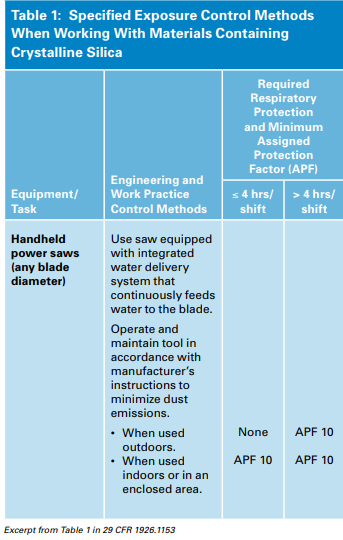The US Department of Labor’s Occupational Safety and Health Administration (OSHA) has recently released a set of 53 Frequently Asked Questions (FAQs) to provide guidance to employers and employees on the Respirable Crystalline Silica Standard for Construction requirements.
Crystalline silica is a common mineral that is found in construction materials such as sand, stone, concrete, brick, and mortar. When workers cut, grind, drill, or crush materials that contain crystalline silica, very small dust particles are created which can travel deep into workers’ lungs and cause silicosis, an incurable and sometimes deadly lung disease.
Respirable crystalline silica also causes lung cancer, other potentially debilitating respiratory diseases such as chronic obstructive pulmonary disease, and kidney disease. In most cases, these diseases occur after years of exposure to respirable crystalline silica.
An estimate from the cancer burden study of the number of deaths from lung cancer associated with exposure to respirable crystalline silica shows there are around 600 deaths per year with 450 of these occurring from exposures in the construction sector, according to UK HSE.
Initially, as of September 2017, the standard was limited to the construction industry, but as of 23 June 2018, a respirable crystalline silica standard has been adopted to cover all employers in the maritime and other industries.
OSHA’s Respirable Crystalline Silica standard for general industry and maritime requires employers to limit worker exposures to respirable crystalline silica and to take other steps to protect workers.
Among other things, OSHA informs that the standard requires employers to:
- Assess employee exposures to silica if it may be at or above an action level of 25 µg/m3 (micrograms of silica per cubic meter of air), averaged over an 8-hour day;
- Protect workers from respirable crystalline silica exposures above the permissible exposure limit (PEL) of 50 µg/m3, averaged over an 8-hour day;
- Limit workers’ access to areas where they could be exposed above the PEL;
- Use dust controls to protect workers from silica exposures above the PEL;
- Provide respirators to workers when dust controls cannot limit exposures to the PEL;
- Use housekeeping methods that do not create airborne dust, if feasible;
- Establish and implement a written exposure control plan that identifies tasks that involve exposure and methods used to protect workers;
- Offer medical exams – including chest X-rays and lung function tests – every three years for workers exposed at or above the action level for 30 or more days per year;
- Train workers on work operations that result in silica exposure and ways to limit exposure; and
- Keep records of exposure measurements, objective data, and medical exams.

The standard (29 CFR 1926.1153) requires employers to limit worker exposures to respirable crystalline silica and to take other steps to protect workers. Employers can either use a control method laid out in Table 1 of the construction standard, or they can measure workers’ exposure to silica and independently decide which dust controls work best to limit exposures in their workplaces to the permissible exposure limit (PEL).
Table 1 matches 18 common construction tasks with effective dust control methods, such as using water to keep dust from getting into the air or using a vacuum dust collection system to capture dust hours per day or any time indoors, he or she would need to use a respirator with an assigned protection factor (APF) of at least 10, such as a NIOSH-certified filtering facepiece respirator that covers the nose and mouth (sometimes referred to as a dust mask).
Alternative Exposure Control Methods
Employers who do not fully implement the control methods on Table 1 must:
- Determine the amount of silica that workers are exposed to if it is, or may reasonably be expected to be, at or above the action level of 25 μg/m3 (micrograms of silica per cubic meter of air), averaged over an 8-hour day;
- Protect workers from respirable crystalline silica exposures above the PEL of 50 μg/m3, averaged over an 8-hour day;
- Use dust controls and safer work methods to protect workers from silica exposures above the PEL; and
- Provide respirators to workers when dust controls and safer work methods cannot limit exposures to the PEL.
The recently published FAQs clarify that the silica standard for construction applies to all occupational exposures to respirable crystalline silica in construction work, except where employee exposures will remain below the AL of 25 μg/m3, calculated as an 8-hour TWA, under any foreseeable conditions.
The exception applies only where exposures below 25 μg/m3 as an 8-hour TWA are expected or achieved without using engineering or other controls. The exception is intended to ensure that the standard does not apply to employees whose work results in only minimal silica exposures.
The FAQs also inform that many silica-generating tasks performed for only 15 minutes or less per day will fall outside the scope of the standard.





























































